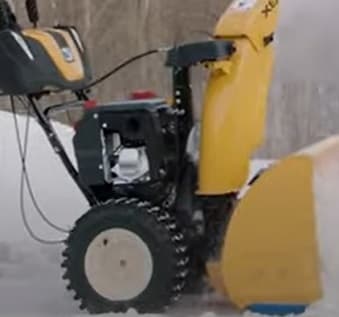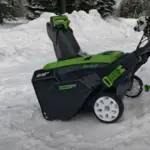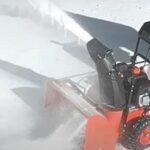As an Amazon Associate, this site earns commissions from qualifying purchases. For more information click here.
It seems like it happens to a lot of folks who use a snow blower. You are clearing and blowing snow then suddenly it stops. The blower won’t move, won’t throw snow and seems to shut down completely. We will go through the top reasons why this happens and solutions. You will also learn the preventive steps you can take.
When fuel is left in a snow blower for a long time, it turns into a gummy substance that can clog the carburetor. This leads to all kinds of problems and often causes it to start and then stall.
Before we begin, keep in mind you will be handling gas snow blowers, and there is a risk each time you work with fuel. Follow all safety precautions and put on protective gear.
Clogged Carburetor
A lot of snow blower problems can be traced back to the carburetor. If your snow blower won’t stay running, the issue is probably here. Usually it is caused by debris or old gummy fuel clogging everything up.
How to Fix It
The first step is look for debris. In some snow blowers, the carburetor is under the air filter, so you have to remove that first. Check your owner’s manual if you are not sure. Remove the debris and turn the engine back on to see if it works.
If that doesn’t work, drain the tank. Clean any fuel residue and pour fresh fuel in. If the blower continues to stall, you need to do a thorough cleaning. You can use Sta-Bil Fast Fix to remove the dirt and grime.
If the carburetor has some worn out parts, you have two choices: buy a carburetor rebuild kit or replace the whole thing. This video shows you how to replace a carburetor.
Old Fuel
Do not leave fuel in the tank unused for more than a month. If you do, the gas transforms into a sticky substance that clogs up the carburetor. This residue also messes up the spark plug and the rest of the engine.
How to Fix It
Check the fuel tank. If the sticky substance is everywhere that means the fuel has turned to gum. There are two solutions.
If you need to do some work immediately, drain the old fuel, wipe the residue and put new fuel in.
If you can spare time, do the following.
- Empty the fuel tank.
- Wipe all traces of the residue in the engine.
- Fill a cup about halfway full of Seafoam. it is a fuel stabilizer that also cleanses the tank
- Pump the primer bulb and pull the starter rope half a dozen times or so.
- Leave it for 6-8 hours.
- Put new fuel in the tank and turn the engine on.
Use the fuel recommended by the manufacturer. Most snow blowers accept regular unleaded gas with 10% or less ethanol.
Related. 5 Reasons Your Snow Blower is Running Rough
Fuel Leak
If the tank has too much fuel, it will leak and cause engine problems. Too much gas will affect the fuel to air mixture too. The excess stuff could spread all over the engine or outside the tank.
How to Fix It
Open the tank. You should see right away if there is too much fuel. Drain the excess until it is at normal level.
If you filled the tank correctly but it seems to lose too much fuel, there might be a leak on the tank itself. Make it a habit to clean and inspect the blower after each use.
The best way to prevent fuel leaks is to pour the exact amount required by your snow blower. This is indicated in the owner’s manual. The tank should have an indicator too how much fuel to put in.
Fuel Cap Vent is Blocked the fuel
As a snow blower runs, the fuel level drops. When this happens, the vent in the fuel cap lets air through. If the cap is blocked, air won’t be able to get in. The resulting vacuum is called a vapor lock.
Engines need a mixture of fuel and air to run. If there is a vapor lock, the lack of air is going to halt the engine. In some cases the engine isn’t going to start at all.
How to Fix It
Loosen the fuel cap but do not take it off. Turn on your snow blower. If it doesn’t stall, that means the fuel cap vent is clogged and must be replaced. You can get a new one rom the manufacturer or third parties that provide compatible products.

Check the Fuel Filter and Fuel Line
If the fuel filter is clogged or the fuel line is damaged, a snow blower cannot function properly. If there is a problem with the filter, it will probably affect the fuel line as well. So it’s best to check both.
The fuel filter serves as a screen to keep dirt out of the fuel. The fuel line moves the fuel from one part of the engine to another. Because of their functions, any clogging has an immediate effect.
How to Fix It
Let’s start with the fuel filter. Check if there is anything blocking it. If there is, the engine won’t get any fuel and it will have problems running.
Replace the fuel filter if it is clogged. Snow blower fuel filters should be replaced once a year for the best results. You can clean the filter but replacements are very cheap so most people just buy a new one.
Check if the snow blower fuel line is connected to the carburetor. If it is, disconnect the line and see how the engine responds.
Sometimes the fuel line is too tight and limits the fuel that gets in the engine. Look for the screw and loosen it a bit.
Fuel lines are vulnerable to damage caused by high ethanol levels in gas. This is just another reason why you should use 10% or lower ethanol fuel.
Damaged Spark Plug
Any time there a snow blower starts and suddenly stops, you should check the spark plug. If your snow blower turns on but stalls when you move it forward, this is likely where the problem is.
How to Fix It
You can clean or replace the spark plug. If it looks burned out, bent or damaged, replace it. If it is covered with dirt but intact, clean it. Use a spark plug tester to verify it is still working.
But if you don’t want to go through that, just replace the spark plug. Look into the manual for the specific spark plug required. Once you have it, disconnect the old one and put the new plug in. Turn on the snow blower if it runs continuously.
Check the Air Filter
Air filters keep the engine cool. It also prevents snow and other debris from accumulating. But with repeated use it is going to get dirty. In some situations, the debris buildup causes the snow blower to start and stop.
How to Fix It
There are two choices, clean or replace the filter. Clean the filter if it is still new or not so dirty. Replace the filter if it is caked with grime or has tears.
To clean a snow blower air filter:
- Take the air filter cover off. You might just need to lift it off or remove screws. You will see the air filter in it.
- Check the filter’s condition. Replace the filter if it is torn. If there is too much dirt you should just replace it. If you want to clean it, follow the next step.
- You have many options to clean the filter. You can leave the filter in a bowl of soapy water or use tap water.
- Squeeze the filter to remove as much dirt as you can. Be careful not rip the filter though.
- Wait for the filter to dry before putting it back in the snow blower.

I love the outdoors and all the tools for maintaining gardens, yards and lawns. The only thing I am more passionate about is sharing what I know about garden and outdoor equipment.


